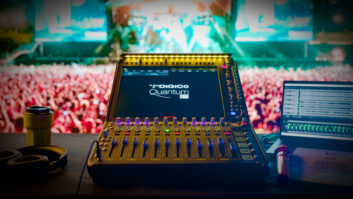The top three TV networks are moving at varying speeds — slow, slower, and even slower — to deliver Dolby Digital 5.1-channel audio with their DTV broadcasts.
ABC delivered some DTV programming in 5.1 in its 1999-2000 season, including the 2000 Super Bowl, Monday Night Football and select movies. For the 2000-01 season, however, the network has confirmed only one 5.1-channel program: D3 The Mighty Ducks movie on June 4. Most of the 32 ABC affiliates that broadcast DTV signals are able to broadcast 5.1, according to Dolby Labs, the developer of Dolby Digital.
NBC, on the other hand, is just getting ready to upgrade its infrastructure to begin delivering Dolby Digital 5.1, but the network — whose only DTV program is Jay Leno’s show — hasn’t announced a target date for delivering multichannel audio broadcasts.
For its part, CBS said it’s still developing a timetable for implementing 5.1-channel broadcasts, but a spokesman noted that for technical and economic reasons, “it’s probably three to five years off before we see a substantial amount of 5.1-channel programming from the networks.” Until then, he expects only select movies and programs to be broadcast in 5.1.
A major reason for the slow pace of implementation, the CBS spokesman explained, is that the FCC approved a Dolby Digital 5.1 “emission standard,” and “no one thought of the infrastructure needed to send it.” The “technology exists to do it, but it costs money, and HD is a money-loser right now [excluding subsidies from consumer electronics manufacturers to finance HD programming].”
For NBC, part of the technology solution is a compression technology called Dolby E, which folds a 5.1-channel signal into a two-channel stream so it can be routed throughout a studio. The technology also simplifies the editing process. Recently, NBC announced its commitment to install Dolby E encoding and decoding equipment in its studios.
Dolby E-encoded audio, compared to a pure Dolby Digital 5.1 stream, withstands multiple encode/decode cycles inherent in the TV audio production process “with much less audible consequence,” said NBC principal engineer Jim Starzynski. Dolby E audio streams are also frame-aligned with video frames to allow for glitch-free editing, he said.
Nonetheless, before NBC is able to deliver 5.1 soundtracks, the network must obtain DTV program material on video tapes that incorporate a compatible multichannel format (either Dolby Digital 5.1 or Dolby E), said Starzynski. NBC must also obtain software that enables the Dolby E soundtrack to pass through its satellites to its affiliates’ IRDs. On top of that, he said, affiliates must install a multichannel decoder and an AC-3 encoder to deliver the soundtrack to their viewers.
“We know what all the pieces are. We’ve tested them, and we’re currently working on making them more available and getting them on line,” Starzynski said. The pieces that the affiliates must buy and install “are very reasonably priced,” he noted.
NBC affiliates in 24 markets are currently delivering HDTV signals.
NBC could have followed ABC in opting to implement 5.1-channel audio without installing Dolby E equipment, Starzynski said, but NBC believes Dolby E will deliver better audio quality to viewers.
For its part, ABC has been delivering 5.1 audio without using Dolby E. A competing network said ABC has been running a 5.1-channel DAT synchronized with a video tape, but ABC did not return calls at deadline for confirmation or to say whether Dolby E is in its future.
CBS also declined to say whether it would adopt the Dolby E solution, pointing out that an older compression technology called Aptex could also be used. But the spokesman also noted that “a large part of the post-production industry in California has gone to Dolby E.” These facilities would remix movies’ 5.1-channel soundtracks for 5.1-channel TV broadcasts.
“The simplest thing is to take material such as movies already mixed in 5.1 and remix them for TV broadcasts,” he said. “In contrast, making a TV series or show in 5.1 means added production costs, and the techniques of recording shows in 5.1 are not well-known. People will be cutting their teeth on this, as they did with surround sound.”
One option for broadcasters would be to synthesize 5.1-channel audio, the spokesman said.
At CBS, 23 affiliates are broadcasting DTV, and the network offers about 16 prime-time hours of DTV programming per week, the network said.
The Fox network didn’t return calls at deadline.













